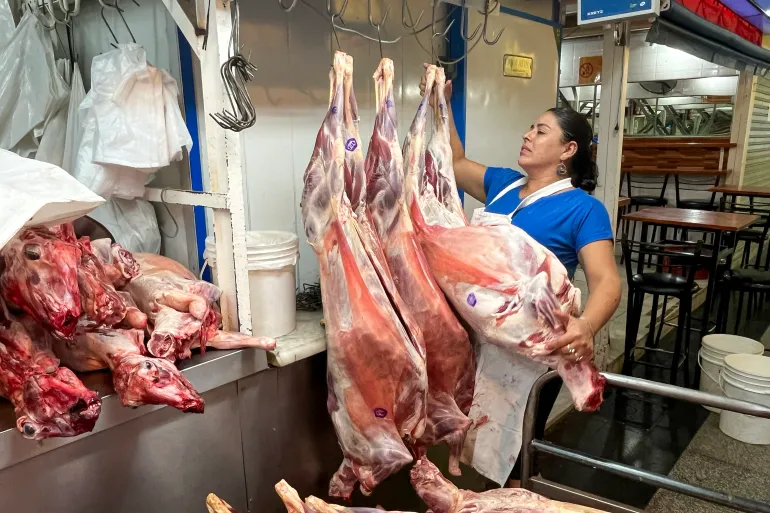In steak-mad Argentina, women’s work is increasingly butchering the meat
Cordoba, Argentina It takes only a brisk walk through Mercado Norte, a nearly century-old food market hall in this city, to discern that in this most carnivorous of countries, meat is the domain of men. Behind the glass counters of the carnicerias, or butcher shops, that make up most of the market’s food stalls, male butchers hold court, knives in hand, while women, if there are any to be seen, are relegated to the cash register.
The gorily stained apron that hangs from her neck identifies Maru Diaz as the exception to the rule.
On a recent Tuesday, Diaz worked alongside two other butchers, both men, to sculpt from goat carcasses recognizable retail cuts: racks of ribs, tenderloins, and bone-in legs, whose meat has become a popular filling for empanadas. This is not a task for the faint-hearted. It begins by hoisting the 23-kg (50-pound) animal on a hook, chopping off its head, and hacking a knife along its backbone to cut the carcass in half.
“I work in a man’s world,” Diaz said matter-of-factly, with goat heads piled up around her feet in what almost appears to be a religious ritual. Some men, after seeing her wield a knife or cleaver, have expressed their surprise in condescending comments that rankle her: “Be careful. You’ll hurt yourself,” or warnings to beware the “armed woman.”.
Also read: At a concert hall close to Moscow, gunmen open fire and throw bombs, leaving 60 people dead.
I like what I do,” said the 36-year-old, her black hair tied up in a bun. “But you have to really want it.”
And it seems more and more women are wanting it
The butcher’s shop, like ‘Disney’
Women like Diaz are increasingly making their mark in the industry, raising their profile while working behind meat counters, and a few are even opening carnicerias of their own. At the same time, new training opportunities aim to further democratize the workplace and spread butchering know-how, creating more opportunities for women and other outsiders.
It’s a shift that carries outsized symbolic weight in meat-loving Argentina, where the asado, or barbecue, is king, where carnicerias dot nearly every city block, and where locals are defying a crippling economic crisis and triple-digit inflation to retain their title as the world’s biggest steak consumers per capita. Argentinians’ identity revolves around steak more than the tango, Malbec wine, Borges, or the legend of Maradona—well, maybe not Maradona.
The 29-year-old Macarena Zarza is all too familiar with this. As a teenager, she happened to walk into a butcher shop and took her first job there out of necessity. After her father passed away from cancer, she left high school to support her family, even though she had always wanted to work in law enforcement. In the vast metropolis of Buenos Aires, she answered an advertisement for a cleaner at the carniceria where she lived.
Years elapsed after months. She filled in for a coworker who was sick and could not make milanesas, or breaded cutlets. Later, the bosses tasked her with grinding beef, pressing hamburgers, and deboning some cuts of meat. Before long, she was spending her lunch breaks and evening hours shadowing other butchers and learning to carve from her boss.
To get to the counter, it took me two years,” Zarza remarked.
Zarza’s passion grew the more she studied. Now, she talks about the need to “respect” carcasses when butchering, drawing comparisons between her love of the trade and the ardor that most Argentinians have for their country’s football team. She founded her own carniceria and traveled to France to hone her skills with master craftsmen. There, she butchers 15 heads of cattle every week by herself. More satisfyingly, she won over clients who had previously told her that a butcher shop was not appropriate for women or that they would prefer to place their order after waiting for a male butcher to arrive. Zarza now oversees a meat processing facility that provides local carnicerias with meat.
ALSO READ: In a video message, Kate Middleton says she is battling cancer after surgery
She declared, “I never received a diploma or a degree.” “However, I demonstrate to people my knife skills.”
A change in career path was necessary for Victoria Vago to become a butcher. She graduated from political science and said that anytime she was in a butcher shop and saw meat all around her, it always made her feel “like at Disneyland.” She left the city government of Buenos Aires in 2018 to work as an apprentice at a neighborhood carniceria.
She did not turn around.
Technique is more important than brute force.
People who can not stand women who butcher often view strength and muscle as necessary qualities for a job, according to Vago and Zarza. However, that is a misconception—and a very old one. Women are just as capable of running a carniceria as men are if they receive the right training and have a firm grasp of carving techniques. Indeed, they said that depending too much on brute force during the butchering procedure might indicate a problem. According to Vago and Zarza, butchering can be considered an art form when done well, and butcher knives are more akin to a sculptor’s chisel than a miner’s pickaxe.
“It is not just about strength. At 157cm (5ft 2 inches), Vago weighs less than half the average side of beef. “If you are working in a place that is properly equipped, if you have good knife technique and know where to cut, you will be fine,” Vago said.
“What makes this not just a man’s job anymore is technique,” Zarza continued.
Although there is no official data on the gender gap in Argentina’s meat industry, government reports state that women’s participation in the workforce as a whole reached a record high last year.
Discussions concerning the meat industry in Argentina frequently center around the term “herencia,” which refers to inheritance. That’s because, for all the national fervor around meat and despite the ubiquity of carnicerias across the country, becoming a butcher is still a haphazard process with no formal pipeline or vocational training programmes for aspiring butchering talent.
The industry’s male-dominated structure is often strengthened by this informality. Male butchers hire their sons, nephews, or friends to work for them so they can eventually take over the businesses and inherit their love for the industry.
Family is the foundation of “butchering knowledge,” according to Zarza.
Luis Barcos is attempting to make that happen.
Educating the future generation of butchers in Argentina
Known for bringing the wagyu breed of beef cattle to Argentina in the late 1990s, Barcos is a veterinarian by training. He has chaired the national food safety agency and is the only Argentinean member of the French Academy of Meat at the moment. His most recent endeavor is the Institute of Meat Sciences and Trades in Buenos Aires, which will launch a butchering course later this year. The course combines classroom instruction with practical workshops.
“In Argentina, there has never been a school for butcher training,” Barcos stated. “I thought we could make something more standardised, more professionalised. Passing on the trade from a father to his son, or from a boss to his employee, is a type of knowledge transfer that is very valid and has created a big labour force.”
Increasing standardization “would undoubtedly really boost women’s participation in the industry,” he stated.
Prominent entities such as the University of Buenos Aires, several federal agencies, a top meat industry magazine, and the French embassy in Argentina all support the Institute of Meat Sciences and Trades. (Barcos’s goal is for French culinary artisans to hold the same level of respect and veneration in France as they do in Argentina.) However, there are other, more at-home training programs that are gaining traction.
Soledad Andreoli is co-owner of a local chain of carnicerias and a slaughterhouse in the sparsely populated province of La Rioja, in the mountainous northeast of Argentina. This month, she converted a portion of the slaughterhouse floor into a training center and opened a free “school for women butchers.”
Andreoli wants to improve the employment prospects for working-class women in the area because most of them have difficulty finding employment outside of domestic work, which employs slightly over 97% women. In addition, she wants to expedite change within the “machista” industry, which she claims has consistently marginalized women.
Transformations and revolutions in culture do not happen overnight. They are not abrupt. Discover your starting point and add your grain of sand in order to break down barriers.
“A change that is here to stay,” according to her, is women working in carnicerias.
“We have entered a different era.”




